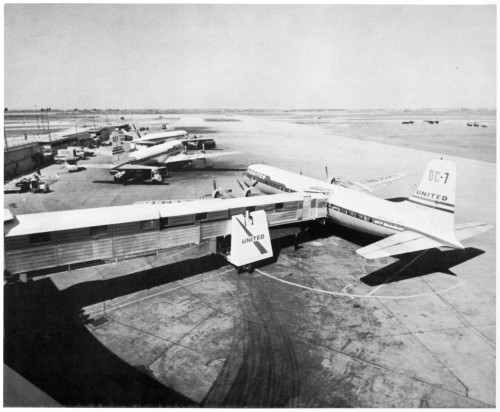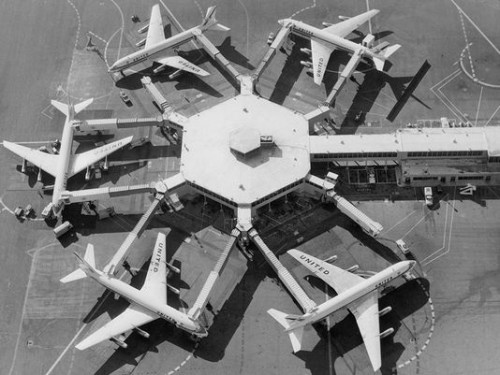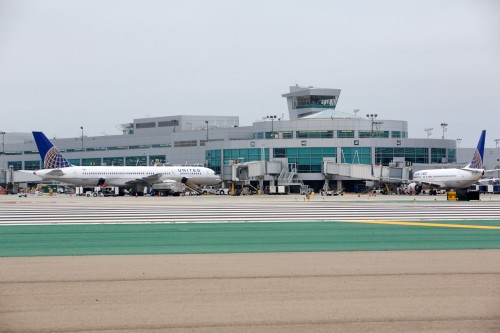Here’s a short history of jet bridges I put together for my At the Airport column on USA TODAY.
In the glamorous “good old days” of air travel, entering or exiting an airplane involved a walk across the tarmac and a climb up or down a flight of movable stairs.
That was fine when the weather was good and all passengers were agile and is still how it’s done at many small airports and for flights at larger airports that arrive and depart on smaller jets.
But sometime in the late 1950s, movable, enclosed metal walkways offering a sheltered pathway between terminals and airplanes began sprouting up at U.S. airports.
“The idea was to protect the passenger and get things moving more quickly,” said Bob van der Linden, curator in the Aeronautics Department at the Smithsonian National Air & Space Museum, but the new passenger boarding bridge also meant air travelers began being isolated “from the romance and the excitement of air travel” in part because “they stopped seeing the airplanes they were boarding.”
Still, van der Linden says a jet bridge or Jetway (the trademarked brand name now often used to describe all passenger boarding bridges, in the same way Kleenex is used for tissues) was a “brilliant idea.”
And although wording on an exhibit panel about early air travel at the Air & Space Museum credits Chicago O’Hare International Airport with introducing the first ‘air bridges,” van der Linden admits that this detail of aviation history is “hard to pin down.”
Various accounts give that credit not only to O’Hare, but to LAX, New York’s LaGuardia Airport, what is now Hartsfield-Jackson Atlanta International and to San Francisco International Airport.
“Although it has appeared in print, SFO is not able to definitively claim having the first ‘Jetway’,” said John Hill, Assistant Director, Aviation at the SFO Museum, but “we are confident to say that the experimental, second story, fully enclosed and retractable passenger loading bridge installed here in 1959 for American Airlines was certainly one of the very earliest.”
According to United Airlines archivists, in 1954 the carrier began testing something called an Air Dock – an enclosed bridge that enabled passengers to walk directly in and out of aircraft without scrambling up and down stairs – and “from those early experiments emerged the telescoping passenger loading bridges now commonly known as jetways.”
Around 1959 the Pacific Iron and Steel Corporation of Los Angeles was contacted by United Airlines to build a “passenger gangway like what they had on cruise ships, but to service aircraft,” said Garrett Macfarlane, Regional Sales Manager for Ogden, Utah-based JBT AeroTech, which now builds the trademarked Jetway passenger boarding bridges.
That turned into an order from United for 19 passenger bridges to be used at what is now New York’s JFK airport, at Los Angeles International Airport and a San Francisco International Airport, said Macfarlane.
A 1959 Airlift article referenced by Aviation Pros tells the story of Delta Air Lines giving Pacific Iron and Steel a first order for 17 “Jetways,” with two prototypes delivered to the Atlanta Airport in July of that year.
“Those first ones were very similar to what you see today – a series of telescoping tunnel sections with wheels,” said Macfarlane. And while the 1961 price of about $100,000 per unit was likely an early deterrent for airlines not used to budgeting for the handy invention, “by the 1970s and 80s most every major airport had them,” he said.
Today, several companies make and market to both airports and airlines a variety of passenger jet bridge styles to service both large and small jets and an A380-capable Jetway unit costs about $600,000.
The now-common airport amenity is now also taken for granted and, in some cases, despised.
A jet bridge is “not quite in the airport, not quite in the airplane,” said Christopher Schaberg, an associate professor at Loyola University New Orleans and the author of The End of Airports, and he’s noticed that for some travelers being inside one can seem like a strange kind of torture.
“Just search Twitter for ‘jet bridge’ and you’ll see people complaining about their brief moments in their tunnels: too hot, too cold, snow seeping in, bad smells, waiting for lazy workers…all the foils of modern life are on display here in the jet bridge,” he said.
Like the security checkpoint, the walk down the jet bridge is a part of the airport experience you want to get through as fast as possible, said Raymond Kollau, founder of airlinetrends.com.
“When boarding the aircraft, it is the final obstacle to overcome before you can finally get into your seat inside the aircraft. The initial relief one has when boarding is announced and you pass the final boarding gate often quickly vanishes because of the traffic jam that usually occurs inside the enclosed jetbridge.”
Not your grandma’s jet bridge
Some airlines and airports have tried transforming the jet bridge experience.
As part of the art program created for the new Terminal B at San Jose International Airport in 2010, speakers were installed in each of 8 jet bridges to accommodate what was a planned series of sound works.
The first was Bill Fontana’s “Sonic Gateway” audio compositions heard by boarding and deplaning passengers from 2011 to 2014.
“The first and last experience a passenger has at an airport is going through a jet way,” said Fontana, “So I spent some time examining the schedules and tried to create sound mixes for these transitional spaces that related to some of the locations airplanes were coming from or going to.’
For example, the sounds of wild Hawaiian chickens was part of the soundscape heard by travelers on their way to Hawaii, while arriving passengers might hear a sound mix that included the bells of Trinity Cathedral in downtown San Jose.
United Airlines is also toying with the jet bridge space with a project designed to inject sensory experiences into jet ways in the form of music, visual branding and scents.
“We are looking at creating an end-to-end branded experience,” said Mark Krolick, the carrier’s Managing Director of Marketing and Product Development, “That includes every aspect of the airport and aboard the aircraft, and the jet bridge is a key piece of that.”
The music part of the project isn’t up and running just yet, but for the past few months United has been experimenting with different ways to diffuse its signature scent – described as a “gender-neutral fragrance with key notes of orange peel, balsam, sandalwood, cedar and leather” – into jet ways at several gates at O’Hare International Airport.
At some airports United owns its own jet bridges, in others it leases them or shares them with other airlines, but for this project Krolick says during 2016 the airline will roll out scenting (and other aspects of the project) at hub airports where it has the most control over the jet bridge environment.
So keep your nose and ears open heading down boarding gates to and from United flights in Newark, Washington- Dulles, Chicago O’Hare, Houston, Denver, Los Angeles and San Francisco.
In the future there may be even more jet bridge innovation.
Fire codes restricting the use of glass walled jet bridges at US airports have recently been lifted, said JBT AeroTech’s MacFarlane, and LEDs allow the mood and lighting inside jet bridges to be easily altered.
“Change comes slowly in the boarding bridge world,” said Macfarlane, “But now that airlines are making money, maybe they’ll start doing some new things.”


